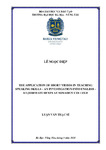Please use this identifier to cite or link to this item:
https://thuvienso.bvu.edu.vn/handle/TVDHBRVT/21043Full metadata record
| DC Field | Value | Language |
|---|---|---|
| dc.contributor.advisor | Pham, Huu Duc (GVHD) | - |
| dc.contributor.author | Le, Ngoc Diep | - |
| dc.date.accessioned | 2024-09-20T08:18:01Z | - |
| dc.date.available | 2024-09-20T08:18:01Z | - |
| dc.date.issued | 2024 | - |
| dc.identifier.uri | http://thuvienso.bvu.edu.vn/handle/TVDHBRVT/21043 | - |
| dc.description.abstract | With the rapid evolution of educational policies and language requirements, local education departments have integrated quantitative assessments of English proficiency into various entrance examinations. Improving students’ English communication skills has become an imperative for English education programs. Traditional teaching methods, however, have proven inadequate in meeting these contemporary demands and can lead to the fossilization of knowledge, hindering students’ ability to apply their language skills in real-world social situations. Consequently, there is an urgent need to develop innovative teaching techniques that enhance the effectiveness and efficiency of English-speaking instruction. The advent of short videos presents a promising opportunity for the reform of speaking teaching methodologies, enabling students to immerse themselves in authentic spoken English without leaving their homes. Short videos can recreate realistic social scenarios, allowing students to observe and understand the correct usage of the language while encouraging them to think and communicate in English. This format offers an accessible and relaxed approach to English-speaking learning while simultaneously fostering cross-cultural awareness. Furthermore, the integration of short videos into classroom instruction provides teachers with a flexible and efficient means to engage students, enhance their enthusiasm for learning, and stimulate their interest in the subject matter. Grounded in the theoretical framework of constructivist learning theory, microlearning theory, and the communicative language teaching (CLT) approach, this study employs a multifaceted methodology, including literature analysis, questionnaire surveys, interviews, and experimental components, to explore the application of short videos in English-speaking teaching at Sonadezi College. The research focuses on students and teachers from two classes at the college, located in Bien Hoa City, Dong Nai Province. Through questionnaires and teacher reviews, the study analyzes the current state of English teaching and learning, as well as the teachers’ and students understanding and utilization of short videos. A four-month teaching experiment was conducted, with one class serving as the control group, receiving conventional speaking instruction, while the other served as the experimental group, incorporating short video-assisted English-speaking teaching. | vi |
| dc.language.iso | en | vi |
| dc.publisher | Trường Đại học Bà Rịa - Vũng Tàu | vi |
| dc.subject | English language -- Study and teaching -- Master's thesis report | vi |
| dc.subject | Anh ngữ -- Học tập và giảng dạy -- Luận văn Thạc sĩ | vi |
| dc.subject | English -- Speaking skill | vi |
| dc.subject | Anh ngữ -- Kỹ năng nói | vi |
| dc.title | The application of short videos in teaching speaking skills - An investigation into English - Majored students at Sonadezi College: Master of TESOL | vi |
| dc.type | Thesis | vi |
| Appears in Collections: | Luận văn ngành Ngôn ngữ Anh | |
Files in This Item:
| File | Description | Size | Format | |
|---|---|---|---|---|
| Le-Ngoc-Diep.pdf | 1,86 MB | Adobe PDF |  Sign in to read |
Items in DSpace are protected by copyright, with all rights reserved, unless otherwise indicated.